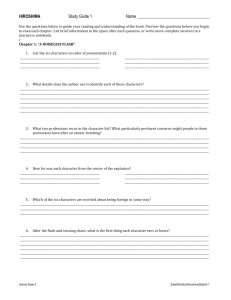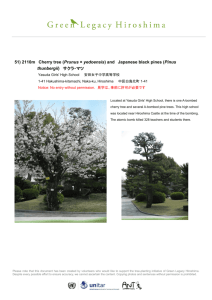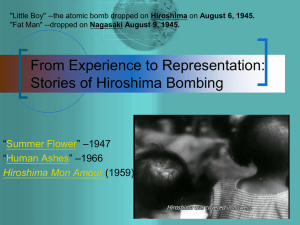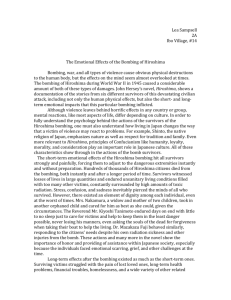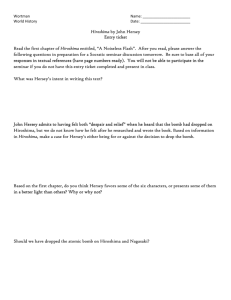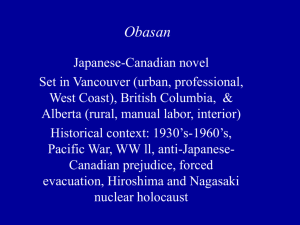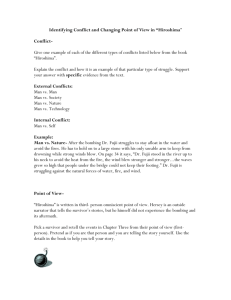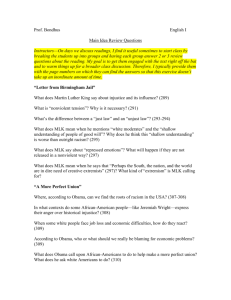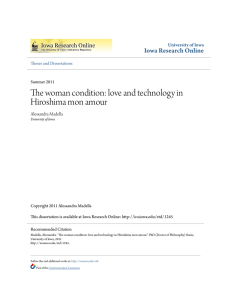Stories of Hiroshima Bombing
advertisement
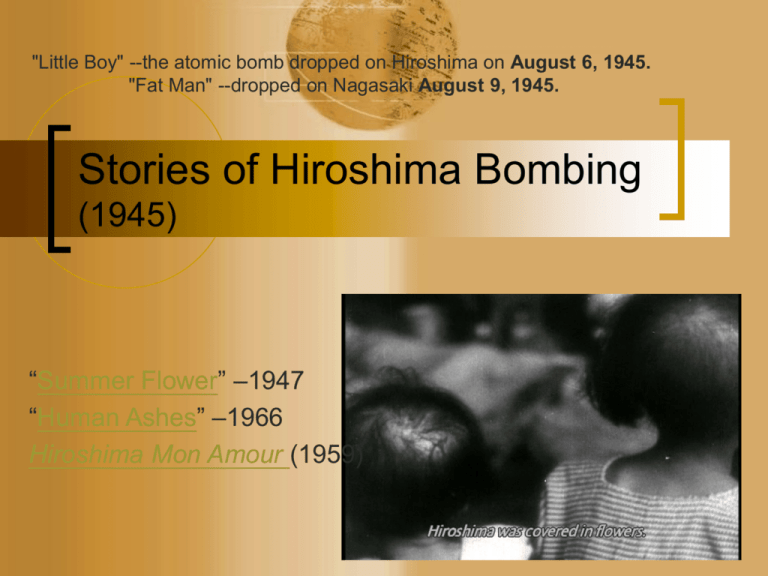
"Little Boy" --the atomic bomb dropped on Hiroshima on August 6, 1945. "Fat Man" --dropped on Nagasaki August 9, 1945. Stories of Hiroshima Bombing (1945) “Summer Flower” –1947 “Human Ashes” –1966 Hiroshima Mon Amour (1959) Hiroshima literature First –generation: witness account or realistic descriptions of the victims; “second- generation survivors”: with a broader perspective, acknowledge clearly that Japan and the Japanese were partly to blame (as aggressors in the Pacific War, and also their invasion of China). First Reactions First experience of the bombing in the three stories: p. 38; p. 68-69 1. 2. lack of understanding, puzzled at not seeing holes 42; helpless; losing contact with the surrounding, numbness p. 73; helping, or being selfish Gaps in memory (“it”; meeting the teacher’s wife), non-verbal memories First reactions: Disgust at injuries 41; 45; 71 ; Wandering or escaping to the river; Hara Tamiki (1905-1951) An English major; familiar with Russian lit, wrote poems himself, too. “Summer Flower” in 1947 “The Land of Heart's Desire” in 1951. -- A suicide note in the form of an account of troubled dreams recalling memories of the Hiroshima bombing. -- The author committed suicide in 1951, when there were rumors about the use of A-Bomb in the Korean war. “Summer Flower” A straightforward account of scenes witnessed by the author after the bomb was dropped on Hiroshima. The story begins with the narrator visiting the graves of his wife and parents three days earlier, and concludes with a friend searching for his wife's remains mingled with the bones of her pupils in the ruins of the girls' school where she taught. He says that the ruins of his house reminded him of The Fall of the House of Usher. The author, who published this narrative in 1947, committed suicide in 1951. “Summer Flower”: Verbal Construction of non-verbal memories Irony: the wife’s grave, flower and incenseFumihiko 51; N’s experience 5354 Central Pattern: searching (to satisfy basic needs) and meeting the injured among broken pieces and corpses. Dominant images: the tree 40; memory of childhood p47voices(46-47) and corpses 51 (“haunting rhythm”) Katsuzo Oda “Human Ashes” (1969) a boy’s experience of displacement and his adolescent desires 64; avoiding his aunt, 64 looking for the aunt 79, seeing the teacher’s wife 82 “Human Ashes” (1969) Compared with “Summer Flower,” does the narrator of this story show greater distance from, or better understanding of, the event? Why does the story take a diary form? Do you see other literary techniques here? “Human Ashes” (1969) Other Ironies: Respect for soldiers/authorities and even kamikaze (神風特攻隊) Death of the figures of authorities 1. 2. 3. 4. 5. 6. the role of the military 64; “a soldier in uniform” 65-66 Dragonfly 69; the lieutenant 71; the student 73; Ichikawa? P. 72 People losing their mind (72; 74) People unable to help each other p. 74; violent when it gets to getting food (crackers) Order and calm –only apparent p. 76 nightmare of childhood Ash-Covered bodies with oil and sweat, streams of blood (76) Human ashes Hiroshima mon amour (1959) What is the film about? -- The atomic destruction of Hiroshima and the psychological consequences of World War II? Director: Alain Resnais Script:Marguerite Duras Actors: Emmanuelle Riva Eiji Okada General Introduction: Background 1959 – the beginning of French New Wave; also the year when Godard's Breathless, Truffaut's The 400 Blows were released. Resnais –By 1959 Resnais had produced a lot of documentaries; e.g. 1955 Night and Fog, which Godard has called a documentary on the “memory of Auschwitz.” After seeing the documentaries already produced on Hiroshima, Resnais changed his mind, asking Duras to write the script for him. General Introduction: Impossibility of Historic representation Reenacting the pain and horror of such events cannot be portrayed in a documentary manner; such representation is possible only if it is mediated through human experiences of love and death. Plot -- the sexual tryst between the French actress, who is married, and her Japanese lover, an architect who is also married, General Introduction: Structure and Plot But the story goes deeper as they dig up her past, and they have a mutual recognition. five panels (not labeled, as such in the film itself): Prologue, Night and Morning, Day, The Café by the River, and Epilogue. General Introduction: Structure and Plot (2) five panels (not labeled, as such in the film itself): Prologue, Night and Morning, Day, The Café by the River, and Epilogue. Starting Questions What does the beginning shots of the film mean? And the opening sequence? "You saw nothing in Hiroshima. Nothing," "I saw everything.... Every thing." What does she see? Remembering and Seeing Bodily memory, or enactment of one’s memory. (bodies in sex = bodies covered by atomic ashes) Opposed to the visualization of memories – museum, park, newsreel, and a film about "peace." What she sees: Hospital with patients averting their faces, documentaries, Hiroshima park and museum Hiroshima at the present time: The film and the parade: Lui (Him) and Elle (Her) Both traumatized; “I was never younger than I was in Nevers.” Forgetting the past Torn between the Past, the Present and future forgetfulness Saying Goodbye to both the Past or the present? Walking thru’ Hiroshima, with flashbacks of Nevers. Elle: I consigned “you” to oblivion. Lui: “We’re sad about leaving each other” Self-Othering Casablanca The ending: What does it mean to call each other by the name of their cities? For next week: Obasan A story about the Japanese’ experience of WWII, both in Canada and in Japan. (Three generations, Issei, Nisei, Sansei.) Protagonist, Naomi + Stephen (3rd), separated from her mother before the war against Japan started; experience two fold relocation (from Vancouver to Slocan to Alberta) lives with their uncle and aunt (Obasan), visited by another aunt (Nisei) The present: Naomi: a timid and unsocialable school teacher. The uncle’s yearly ritual on 8/9 ( 1951 the bombing of Nagasaki) For next week: Obasan (2) The death of the uncle brings Naomi back to Obasan’s house, the question about the mother arises again. Aunt Emily’s package Naomi starts to remember the past; The present moment –Obasan’s package (with the grandmother’s letter) Our focus: the mother’s silence and final communication the avenues of silence are the avenues of speech 228 ==233 “There is a silence that cannot speak; there is a silence that will not speak.”
